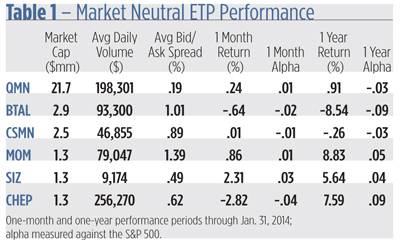Matthew Green, an 18th century British poet, once reflected upon a personal ethos that today’s equity investors might do well to embrace: “Thus, I steer my bark, and sail on even keel, with gentle gale.”
The tempest roiling the market nowadays can hardly be described as gentle but there’s a way for stock punters to keep systematic risk at bay while trolling for alpha. Value, capitalization and other thematic plays can be exploited with “market neutral” products, portfolios that attempt to cancel out distracting, and sometimes destructive, beta noise.
Beta has certainly been a bugaboo in the opening days of 2014. Ask anybody who owns the SPDR S&P 500 ETF (NYSE Arca: SPY). Following a year-end double top, SPY—a benchmark for domestic large-cap stocks—lost 3.5 percent in January. At the same time, a half-dozen market neutral exchange traded products (ETPs) gained an average 0.1 percent with a weighted beta near zero. That’s pretty good evidence of market neutrality (half of the ETPs actually earned positive alpha in January).
Underlying the typical market neutral product is an actual or simulated portfolio equally weighted in long and short exposures. The strategy pays off when one side of the portfolio outdoes the other. The operating thesis is simple in concept: capture the outperformance or underperformance of certain types of stocks rather than relying upon the rise or fall of the broad market. By balancing dollar, sector and sometimes regional allocations within the portfolio, portfolio managers can exploit various macroeconomic themes.
Investors, however, haven’t been enamored with these funds. Given the equity market’s rocket-like trajectory last year, it’s really no wonder. Market neutral strategies could prove more alluring now that the love affair with beta has waffled, but investors and their advisors need to be aware of potential pitfalls.
First and foremost is the risk of product demise. Five of the market neutral ETPs are denizens of the ETF Deathwatch, a widely followed roster of moribund funds and notes published by Ron Rowland, chief investment officer of Texas-based Capital Cities Asset Management.
Funds are condemned to the Deathwatch if, for three or more consecutive months, their average daily dollar volume falls below $100,000 or if their market capitalization drifts under $5 million for a calendar quarter or longer. (ETPs are typically considered viable when market capitalization exceeds $25 million.)
 The Lone Note
The Lone Note
The big daddy of market neutral ETPs (and the only one not presently foundering) is, oddly enough, an atypical product. The IQ Hedge Market Neutral Tracker ETF (NYSE: QMN), unlike the others, isn’t built on a long/short framework. Instead, QMN takes a fund-of-funds tack. Holding more than a dozen ETPs, QMN’s managers achieve beta neutralization with fixed income and currency exposures. More than 70 percent of the fund’s assets, in fact, are given over to non-equity products. Global stock exposure comes from ETPs tracking the Russell 2000 index and the MSCI EAFE and Emerging Market indices.
This setup may explain QMN’s relatively high correlations to equity and fixed income. Against the S&P 500 for example, QMN’s R-squared coefficient is .47, versus an average of zero for the other ETPs (1.00 is 100 percent correlated). It also dampens the fund’s volatility. With an annualized standard deviation of just 3.2 percent, QMN’s price variability is roughly half that of competing products.
QMN doesn’t suffer the cash drag of short sales but, as a trade-off, absorbs the passed-through costs of its acquired ETP portfolio. Still, with a total expense of 91 basis points (.91 percent), QMN is among the cheapest market neutral products.
None of the market neutral ETPs are traded with much gusto, but QMN is easily the category’s most liquid, at least as reflected by its relatively narrow bid/ask spread. Still, there was no trading in QMN shares one out of 10 days over the past year. It’s not that there’s a paucity of shares. There are plenty—850,000 outstanding—so market makers have a fair amount to work with. It’s all about investor interest.
Another Global Exposure
Another product, the Credit Suisse Market Neutral Equity ETN (NYSE Arca: CSMN), also takes a global approach. CSMN, the only exchange traded note of the lot, tracks an index comprised of North American, European and Japanese stocks, sorted on the basis of their cash flows, valuation metrics and investor sentiment. CSMN’s value reflects the difference in the return of two equally weighted short and long sub-indices.
In the index methodology, eligible stocks from each region are grouped into sectors and ranked. Strong stocks are lumped into the long sub-index while weak issues comprise the short side. Each exposure on the long side is then matched sector-by-sector and region-by-region with a short sub-index to create market neutrality.
Since buyers’ bets go beyond the U.S. shore, CSMN’s benchmark is more properly a worldwide equity index, not the S&P 500. Recently, that’s been a distinction without much difference as CSMN’s performance relative to the MSCI All-County World Index fairly well mirrored its showing against the domestic yardstick.
Though CSMN has a weak correlation to domestic equities, its S&P 500 beta exposure actually strengthened in January, the mirror image of QMN’s history.
CSMN notes are issued by the Nassau branch of A-rated Credit Suisse AG. As such, CSMN lays credit risk on its investors. Credit Suisse’s ability to deliver the index return is subject to the bank’s financial health which, as we’ve seen recently, is a variable.
CSMN is one of the category’s most lightly traded ETPs. Trading volume averages just 3,100 notes a day and has been falling. This ETP definitely trades by appointment. Over the past year, no volume was posted for 60 percent of CSMN’s market sessions.

Domestic Market Neutrality
The rest of the market neutral ETP field is populated by funds marketed under the QuantShares brand. QuantShares was first to market with a suite of seven products offering plays on domestic equity factors such as beta, capitalization, quality, momentum and value.
Three of these funds barely survived a year. In November 2012, the U.S. Market Neutral High Beta Fund (NYSE Arca: BTAH), the U.S. Market Neutral Quality Fund (NYSE Arca: QLT) and the U.S. Market Neutral Anti-Momentum Fund (NYSE Arca: NOMO) were liquidated due to weak demand.
Survival of the four remaining QuantShares funds is iffy. Collectively, their assets amount to less than $7 million with a combined daily turnover of just $358,000. The ETP landscape would be poorer for their closure, since these funds are completely portable adjuncts that can diversify portfolio risk, preserve capital and minimize drawdowns.
The largest is the U.S. Market Neutral Anti-Beta Fund (NYSE Arca: BTAL), a portfolio that screens the largest 1,000 domestic issues for liquidity, buying low-beta stocks and selling those with higher coefficients. This strategem bestows BTAL with the lowest beta of all the market neutral ETPs. Cozying up to beta turned out to be the ideal tactic last year, so it’s no surprise that BTAL buyers took a gut punch. The fund’s relatively high volatility yielded the category’s lowest one-year alpha (-.09).
BTAL trades with some of the widest spreads in the category, though trading volume is fairly active in context. In the past year, there were 77 (30 percent) zero-volume days.
Investors wanting to bet on recent market winners can capture the spread between high and low momentum stocks with the U.S. Market Neutral Momentum Fund (NYSE Arca: MOM). Momentum is based on stocks’ total return over the preceding 12 months. Issues with the greatest total returns are ranked high; lower ranks are filled with low-return shares. High-ranked stocks are bought while low-ranked issues are sold short.
From a return perspective, momentum was the best of the market neutral plays last year, but because of the fund’s higher volatility, it was a second-best alpha generator.
With only one creation unit (50,000 shares) outstanding, MOM’s liquidity is very poor. Spreads are the category’s widest and trading is sparse. More than half of the time, in fact, there’s no volume at all.
Small-cap stocks get singled out with the U.S. Market Neutral Size Fund (NYSE Arca: SIZ). The fund’s index methodology calls for the purchase of the lowest capitalized stocks and short sales of the highest capitalization issues in equal dollar amounts within each market sector.
As far as returns go, small was good last year and seems to be just as good, if not better, in 2014. Not many investors are willing to risk a play on the small side, though. SIZ has the category’s lowest average trading volume, though spreads are relatively narrow. Here’s a heart-stopper: A whopping 79 percent of SIZ’s trading days last year were zero-volume sessions.
If cheap is what you like, the QuantShares U.S. Market Neutral Value Fund (NYSE Arca: CHEP) might be your man. The fund buys cheap stocks, measured by forward earnings, book value and cash flow ratios while selling short, in equal dollar amounts, the priciest shares. Basically, it’s a value versus growth play.
CHEP was the top alpha generator last year, but started 2014 on the back foot as investors booked profits from previous value plays.
The fund exhibits fair liquidity (for a market neutral ETP, anyway) but, like MOM and SIZ, there’s only one creation unit—50,000 shares—outstanding. Only 27 percent of last year’s trading sessions were zero-volume days.
Pay to Play
Market neutral products are designed to reduce risk. The trouble is, trading into or out of these ETPs is now a risk unto itself. A slug of products have already been liquidated and most of the survivors seem to be perilously close to winding down. This deters new investment. After all, there’s little advantage to buying a tool if it’s soon stolen from you.
There’s also the issue of expense. While stated expenses average 76 basis points, the cost drag of short sales and shrinking asset bases effectively doubles the tariff. Overheads won’t diminish until and unless more shares are created.
Market neutral strategies, long used by institutional investors, have historically been foreclosed to retail investors. Market neutral ETPs were launched to provide retail holders cost-efficient, liquid and transparent alternatives to the active strategies and derivatives utilized by big money.
Epicurus once said that skillful pilots gain their reputation from storms and tempest. Investors plying the market neutral waters with ETPs are now being sorely tested.






